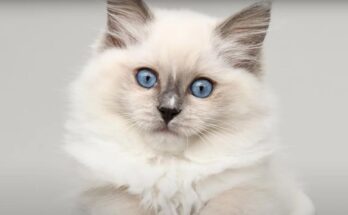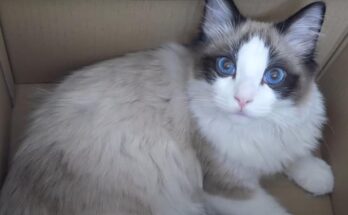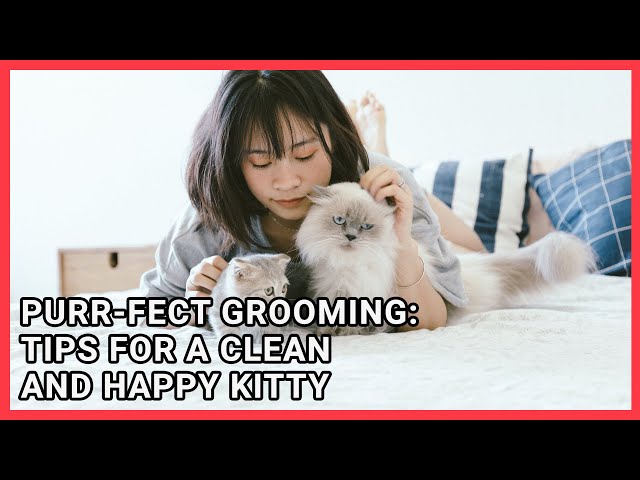Ragdoll cats can experience health issues with their tails, including kinks and paralysis. These conditions can be caused by various factors such as trauma, genetics, or infection.

Credit: www.facebook.com
The Ragdoll Cat Breed
The Ragdoll cat breed is known for its striking appearance and friendly nature. Originating in the United States in the 1960s, Ragdolls are large, muscular cats with silky fur and captivating blue eyes. They are often described as gentle giants due to their size and docile temperament. Ragdolls are popular pets due to their affectionate and sociable nature, making them a delightful addition to any household. In this article, we will explore the characteristics, personality, and health issues that can affect the tails of Ragdolls.
Origin And Characteristics
The Ragdoll cat breed was created by Ann Baker in Riverside, California. She experimented by breeding a white Persian cat with unique characteristics with a Burmese and Birman cat. The result was a large, semi-longhaired breed with captivating blue eyes and a striking coat pattern. Ragdolls are known for their distinctive color point markings, which develop as the cats reach maturity. These markings typically consist of a lighter body color with darker shades on the face, ears, paws, and tail.
Ragdolls are large, sturdy cats with a muscular build. Adult males can weigh between 15 to 20 pounds, while females typically range from 10 to 15 pounds. Their coats are luxurious, soft, and easy to maintain thanks to a low matting tendency. The breed’s semi-long hair and subtle coloring make them visually appealing, and their large, expressive blue eyes captivate the hearts of their owners. With their calm and gentle demeanor, Ragdolls easily earn their reputation as loving and affectionate companions.
Personality And Traits
Ragdolls are renowned for their incredibly affectionate and relaxed nature. They enjoy spending time with their human families and seek out attention and companionship. These cats are known to be particularly loyal and develop strong bonds with their owners.
Ragdolls are also known for their docile temperament, often going limp when picked up, hence the name “Ragdoll.” This trait makes them well-suited for families with children or other pets, as they are generally tolerant and patient. They thrive on human interaction and are often found following their owners around the house, curious about their activities.
Playfulness is another characteristic of Ragdolls. Despite their calm nature, they enjoy interactive play sessions with their owners. This breed is intelligent and can learn tricks or play fetch, making them an engaging and entertaining addition to any household. Ragdolls easily adapt to different environments and lifestyles, making them a popular choice among cat lovers.

Credit: cats.com
Anatomy Of Ragdoll Tails
Ragdoll cats are prone to issues with their tails, including kinks, breaks, and nerve damage. These can result from accidents or spinal abnormalities. Caregivers should monitor their Ragdoll’s tail for any signs of discomfort or injury, seeking veterinary care if necessary.
Regular check-ups can help prevent and address tail-related health issues.
Structure And Function
The anatomy of Ragdoll cat tails is a fascinating subject that sheds light on the unique features and health issues that may affect these adorable feline companions. Understanding the structure and function of their tails plays a crucial role in recognizing potential health concerns and providing appropriate care. Let’s dive into the intricate details:
The Ragdoll tail consists of a series of small bones called vertebrae, which are connected by flexible joints known as intervertebral discs. This design allows for a wide range of motion, including swishing, curling, and wagging. Not only does the tail serve as a balance and communication tool, but it also contributes to the overall elegance and beauty of these magnificent cats.
Unique Features
One of the most remarkable features of a Ragdoll’s tail is its length. These cats are known for having relatively long tails compared to other breeds. The length can vary from cat to cat, but it typically extends beyond the length of their bodies. This elongated tail adds to their enchanting appearance and serves as an extension of their graceful presence.
In addition to its length, the Ragdoll tail is also famous for its luxurious, silky fur. The tail is adorned with a thick coat of fur that matches the color and pattern of the cat’s body. The texture and softness of their tail fur make it irresistible to touch, giving these cats an extra dose of cuddliness.
The shape of the Ragdoll tail is another distinguishing characteristic. It is generally tapered, starting off thick at the base and gradually becoming thinner towards the tip. This tapered shape allows for more precise movements and enhances the cat’s agility and balance.
Furthermore, Ragdolls have a unique ability to control the flexibility of their tails. These cats can manipulate the position and posture of their tails to express various emotions. A raised tail indicates happiness and contentment, while a tucked tail suggests fear or discomfort. This tail language adds an intriguing dimension to their communication with humans and other animals.
Understanding the anatomy and unique features of Ragdoll tails is essential for maintaining their health and well-being. Any abnormalities or changes in tail appearance, mobility, or behavior should be promptly addressed by a veterinarian to ensure proper care and treatment. By observing and appreciating their tails’ structure and function, we can deepen our connection with these magnificent cats and provide them with the love and care they deserve.
Common Health Issues In Ragdoll Tails
Ragdoll cats are known for their sweet and affectionate nature, as well as their beautiful silky coats and striking blue eyes. However, like any other breed, they are prone to certain health issues that can affect their tails. Knowing the common health issues in Ragdoll tails can help pet owners understand how to provide the best care for their feline companions.
Injuries And Fractures
Injuries and fractures in Ragdoll cat tails can occur due to accidents, trauma, or mishandling. These gentle and trusting cats may inadvertently find themselves in situations where their tails are harmed, leading to fractures and other injuries. It’s essential for pet owners to handle their Ragdoll cats with care and be mindful of their surroundings to prevent such incidents.
Nerve-related Problems
Ragdoll cats can also experience nerve-related problems in their tails, which may lead to issues such as nerve damage or loss of tail function. This can result from various conditions or injuries that affect the nerves in the tail, impacting the cat’s mobility and comfort. Identifying and addressing any signs of nerve-related problems promptly is crucial for maintaining the well-being of Ragdoll cats.
Tail Infections
Tail infections can afflict Ragdoll cats, causing discomfort and potential complications if left untreated. These infections may stem from wounds, insect bites, or skin conditions, leading to inflammation and discomfort in the tail area. Pet owners should regularly inspect their cat’s tail for any signs of infection and seek veterinary attention if any issues arise.

Credit: issuu.com
Symptoms And Warning Signs
Ragdoll cats can experience health issues affecting their tails. Common symptoms include limpness, sensitivity, and decreased mobility, signaling a need for veterinary attention. Observing warning signs promptly may prevent worsening conditions.
Symptoms and Warning SignsVisible Changes In Tail
Ragdoll cats may exhibit swelling or inflammation at the base of their tail, which can signal underlying health issues.
Behavioral Cues
Spontaneous tail lashing and sensitivity to touch could indicate pain or discomfort in Ragdolls.
Preventive Care Measures
Ragdoll cats are prone to specific health issues related to their tails. By implementing preventive care measures, you can safeguard your feline friend’s tail health.
Regular Veterinary Check-ups
- Schedule annual vet visits for tail health assessment.
- Detect any tail issues early for timely treatment.
- Consult your vet regarding tail-specific care practices.
Tail-specific Exercises And Activities
- Engage your Ragdoll in tail exercises tailored by your vet.
- Incorporate interactive toys and games for tail movement.
- Avoid activities that strain or pull the tail excessively.
Treatment Options For Tail Conditions
Ragdoll tails are a distinctive feature of this beloved breed, but they can be prone to specific health issues that affect their tails. Prompt and proper treatment is essential to ensure the well-being and comfort of these affectionate feline companions. Here, we’ll explore the various treatment options available for tail conditions in Ragdolls.
Medication And Pain Management
Ragdoll cats experiencing tail conditions may benefit from prescribed medications to alleviate discomfort and manage underlying issues. Pain relief, anti-inflammatory drugs, and antibiotics are commonly used to address tail-related ailments. It is crucial to administer medications as directed by a qualified veterinarian to ensure the best possible outcomes for the Ragdoll’s tail health and overall well-being.
Tail-specific Surgeries
In cases where medication alone cannot resolve the tail condition, tail-specific surgeries may be recommended. Surgery can be necessary for addressing issues such as injury, infection, or certain structural abnormalities affecting the tail. Tail amputation may also be considered in severe cases, under the supervision of a skilled veterinary surgeon who can provide appropriate guidance and post-operative care.
Lifestyle Adaptations For Ragdoll Tails
Ragdoll cats are known for their long and luxurious tails, which add to their overall elegance and charm. However, this distinctive feature can also make them more susceptible to certain health issues. As responsible pet owners, it’s important to make lifestyle adaptations that cater to their specific tail-related needs. In this article, we will explore the necessary lifestyle adaptations for Ragdoll tails to ensure the well-being and comfort of these lovely feline companions.
Tail-friendly Living Environment:
Creating a tail-friendly living environment is crucial for the overall health and comfort of your Ragdoll cat. Here are some tips to consider:
- Provide ample space for your Ragdoll to move around and maneuver its tail without obstruction.
- Arrange furniture and obstacles in a way that minimizes the risk of tail injuries. Ensure that there are no sharp edges or narrow spaces where the tail can get caught.
- Keep fragile items and decorations out of the cat’s reach to prevent accidental tail damage.
- Create vertical spaces like cat trees or shelves for your Ragdoll to climb and rest, allowing it to freely drape its tail without any discomfort.
- Ensure a clean living environment by regularly removing debris or any potential hazards that may pose a risk to your cat’s tail.
- Provide scratching posts to encourage healthy scratching habits and minimize the chances of tail injuries caused by inappropriate scratching surfaces.
Tail Ergonomics In Daily Life:
Incorporating tail ergonomics into your Ragdoll’s daily life can greatly reduce stress on its tail and prevent potential health issues. Here are some suggestions to promote tail-friendly behavior:
- Handle your cat with care when touching or lifting its tail. Gently support the tail to avoid placing strain on the joints.
- During grooming sessions, use gentle techniques and avoid pulling or tugging on the tail.
- Brush your Ragdoll’s tail regularly to prevent tangles or mats that can lead to discomfort or pain.
- Encourage your cat to engage in regular exercise to maintain a healthy weight, reducing the risk of tail-related issues.
- Observe your cat’s body language and tail movements to ensure it feels comfortable in different situations.
- If you notice any changes in your cat’s tail such as swelling, redness, or sensitivity, consult a veterinarian promptly.
Understanding Tail Care And Maintenance
Grooming Techniques
Ragdoll cats have long, beautiful tails that require regular grooming to keep them healthy and free from mats and tangles. Here are some grooming techniques to consider:
- Brush your cat’s tail gently using a slicker brush to remove loose hair and prevent matting.
- Comb through the tail with a wide-toothed comb to tackle any remaining tangles.
- Trim any excess fur around the tail to maintain its length and prevent it from getting tangled.
- Regularly check the tail for any signs of skin irritation, redness, or parasites. If you notice anything unusual, consult your veterinarian for proper diagnosis and treatment.
Nutritional Considerations
Proper nutrition is essential for maintaining a healthy tail in your Ragdoll cat. Consider the following nutritional considerations:
- Choose a high-quality cat food that provides a well-balanced diet of protein, fat, and carbohydrates, along with essential vitamins and minerals.
- Ensure your cat’s diet includes omega-3 fatty acids, which promote healthy skin and coat, including the tail.
- Avoid feeding your cat excessive amounts of treats or human food that can lead to weight gain and related health issues.
- Provide fresh water at all times to keep your cat hydrated and support overall health.
In conclusion, understanding tail care and maintenance is crucial for the health and well-being of your Ragdoll cat. Regular grooming techniques and proper nutritional considerations can help prevent tail issues and ensure your feline friend’s tail remains beautiful and problem-free.
Frequently Asked Questions For What Health Issues Affect Ragdoll Tails?
What Health Issues Can Affect Ragdoll Cat Tails?
There are several health issues that can affect Ragdoll cat tails, including nerve damage, trauma, infection, and ringworm. It’s essential to monitor your cat’s tail for any changes in behavior or appearance and consult a veterinarian if any concerns arise.
How To Prevent Health Problems In Ragdoll Cat Tails?
To help prevent health problems in Ragdoll cat tails, ensure your cat’s environment is safe and free of hazards. Regular veterinary check-ups, a balanced diet, and proper grooming can also contribute to maintaining a healthy tail for your Ragdoll cat.
Why Is It Important To Pay Attention To Ragdoll Cat Tails?
Ragdoll cats are known for their beautiful long tails, which are crucial for their balance and communication. Monitoring their tails can help detect any potential health issues early on, improving their overall well-being and quality of life.
Conclusion
Understanding the health issues that affect Ragdoll tails is crucial for their well-being. By recognizing potential problems and seeking early intervention, owners can ensure their cats lead happy and healthy lives. Regular monitoring and veterinary check-ups are essential for maintaining the overall health and comfort of Ragdolls.
Proper care and attention can mitigate potential tail-related issues and promote the long-term health of these beloved feline companions.



